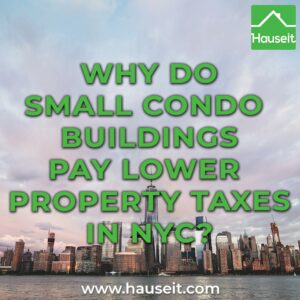An interesting quirk of NYC’s current property tax system is that homeowners in condo and co-op buildings with 10 or fewer units pay lower property taxes compared to unit owners in buildings with 11 or more apartments.
In other words, two comparably sized NYC condos in the same neighborhood (with similar market values) can have large disparities in property taxes solely due to the number of apartments in each respective building.
We observe this phenomenon in the example below, where two comparably sized pre-war condos in the Lower East Side of Manhattan have wildly different property tax bills:
175 East Broadway #2A (30-unit building)
-
Square Footage: 1,345
-
Annual Property Taxes: $27,690.96 (see bill here)

184 Bowery #2 (5-unit building)
-
Square Footage: 1,347
-
Annual Property Taxes: $16,418.28 (see bill here)

The owner of 175 East Broadway #2A pays an additional $11,272.68/year in property taxes compared to the owner of 184 Bowery #2, even though both properties have virtually identical square footage.
It’s even more puzzling that 175 East Broadway pays significantly higher property taxes considering it’s in a slightly less desirable location compared to 184 Bowery.
Both condo buildings in this example are considered ‘Class 2’ properties by the NYC Department of Finance and have a similar tax computation methodology, so how is such a disparity possible?
The reason is that Class 2 buildings with 10 or fewer units benefit from a state law which caps assessed value increases at 8% from the prior year or 30% over five years. In our example, the beneficiary of this law is 184 Bowery.
There is no such assessed value growth cap for Class 2 buildings with more than 10 units. In our example, 175 East Broadway falls in this category since it has more than 11 apartments (30 to be exact). However, changes in assessed value for condo buildings with 11 or more units are phased in over a five-year period.
While this smooths out changes over the years, it does not create any outright cap on growth rates as is the case for Class 2 buildings with 10 or fewer units.
Save 2% On Your Home Purchase
Save thousands on your home purchase with a buyer agent commission rebate from Hauseit
Let’s consider another example of the disparity in property taxes between small and large NYC condo buildings in Williamsburg, Brooklyn:
242 South 1st Street #2E (23-unit building):
-
Square Footage: 663
-
Annual Property Tax: $8,331.96 (see bill here)
167 Devoe Street #2A (6-unit building):
-
Square Footage: 714
-
Annual Property Tax: $2,740.28 (see bill here)
These are two comparably sized one-bedroom apartments, yet the owner of the condo in the larger building pays over three times more in property taxes!
Interestingly, one- to three-family homes in NYC (Class 1 properties) also benefit from an assessed value growth cap similar to that of apartment buildings with more than 10 units.
State law caps assessed value increases for Class 1 properties at 6% from the prior year or 20% over five years. These caps are more restrictive than the respective 8% and 30% limits for buildings with 11 or more units.
The assessed value growth cap on Class 1 properties is the reason why townhouses in rapidly gentrifying parts of Brooklyn (such as Bed-Stuy and Bushwick) have significantly lower property when compared to similar properties in Manhattan.





